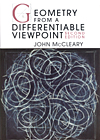- About MAA
- Membership
- MAA Publications
- Periodicals
- Blogs
- MAA Book Series
- MAA Press (an imprint of the AMS)
- MAA Notes
- MAA Reviews
- Mathematical Communication
- Information for Libraries
- Author Resources
- Advertise with MAA
- Meetings
- Competitions
- Programs
- Communities
- MAA Sections
- SIGMAA
- MAA Connect
- Students
- MAA Awards
- Awards Booklets
- Writing Awards
- Teaching Awards
- Service Awards
- Research Awards
- Lecture Awards
- Putnam Competition Individual and Team Winners
- D. E. Shaw Group AMC 8 Awards & Certificates
- Maryam Mirzakhani AMC 10 A Awards & Certificates
- Two Sigma AMC 10 B Awards & Certificates
- Jane Street AMC 12 A Awards & Certificates
- Akamai AMC 12 B Awards & Certificates
- High School Teachers
- News
You are here
Geometry from a Differentiable Viewpoint

Publisher:
Cambridge University Press
Publication Date:
2013
Number of Pages:
357
Format:
Paperback
Edition:
2
Price:
45.00
ISBN:
9780521133111
Category:
Textbook
The Basic Library List Committee recommends this book for acquisition by undergraduate mathematics libraries.
[Reviewed by , on ]
William J. Satzer
02/20/2013
This is the second edition of a fresh look at introductory differential geometry for undergraduates. The book manages to be a little traditional and a bit avant-garde at the same time. The author notes that students usually come to his course having taken introductory analysis, but with no connection to geometry since high school. In the absence of a fuller sense of the meaning of geometry, its history and its beauty, these students — he fears — will view their experience with differential geometry as something different and unconnected. His goal is to integrate the pieces, to make the connections, and to take the student from the familiar neighborhood of Euclidean geometry to the state of development of differential geometry at the beginning of the twentieth century.
The book is structured in sonata-allegro form, with Parts A, B and C (exposition, development and recapitulation). The prelude of Part A is a short chapter on spherical geometry. It’s a good choice: not review, not entirely new, a kind of orientation and preview. The themes include chapters on Euclidean geometry, the theory of parallels and synthetic non-Euclidean geometry. At the conclusion of Part A what’s missing is a concrete and rigorous model of a non-Euclidean geometry that’s not embedded in Euclidean space. The resolution comes in Part C.
Part B begins with the differential geometry of curves and surfaces. This is mostly a standard treatment, but it is clear and well-written. Closely following is a chapter on map and map projections — an immediate application of the ideas and techniques from the theory of surfaces. Part B continues with chapters on curvature, metric equivalence of surfaces, and geodesics. Then the author presents The Gauss-Bonnet theorem for surfaces and its proof. He concludes Part B with a discussion of surfaces of constant curvature.
Part C departs some from the usual course of introductory material. It begins with an introduction to “abstract surfaces” (two-dimensional manifolds). And then fulfills the promise of Part A by creating models of the non-Euclidean plane (Beltrami and Poincaré disks and Poincaré half-plane). The final chapter is called an epilogue but is a kind of advertisement of things to come: how to build on the ideas of the differential geometry of surfaces to understand the geometry of higher dimensions. In an appendix the author includes a translation of Riemann’s famous lecture on the foundations of geometry. (This is a slightly edited version of Spivak’s translation in the second volume of A Comprehensive Introduction to Differential Geometry.)
This book is an appealing introduction to differential geometry that is fully accessible to undergraduates. It is well-paced and clearly written, with a good sense of the historical context. The text enables several possible different courses ranging from very traditional differential geometry of curves and surfaces to a course that develops a broader perspective of geometry.
Bill Satzer (wjsatzer@mmm.com) is a senior intellectual property scientist at 3M Company, having previously been a lab manager at 3M for composites and electromagnetic materials. His training is in dynamical systems and particularly celestial mechanics; his current interests are broadly in applied mathematics and the teaching of mathematics.
Part I. Prelude and Themes: Synthetic Methods and Results: 1. Spherical geometry
2. Euclid
3. The theory of parallels
4. Non-Euclidean geometry
Part II. Development: Differential Geometry: 5. Curves in the plane
6. Curves in space
7. Surfaces
8. Curvature for surfaces
9. Metric equivalence of surfaces
10. Geodesics
11. The Gauss–Bonnet theorem
12. Constant-curvature surfaces
Part III. Recapitulation and Coda: 13. Abstract surfaces
14. Modeling the non-Euclidean plane
15. Epilogue: where from here?
- Log in to post comments




